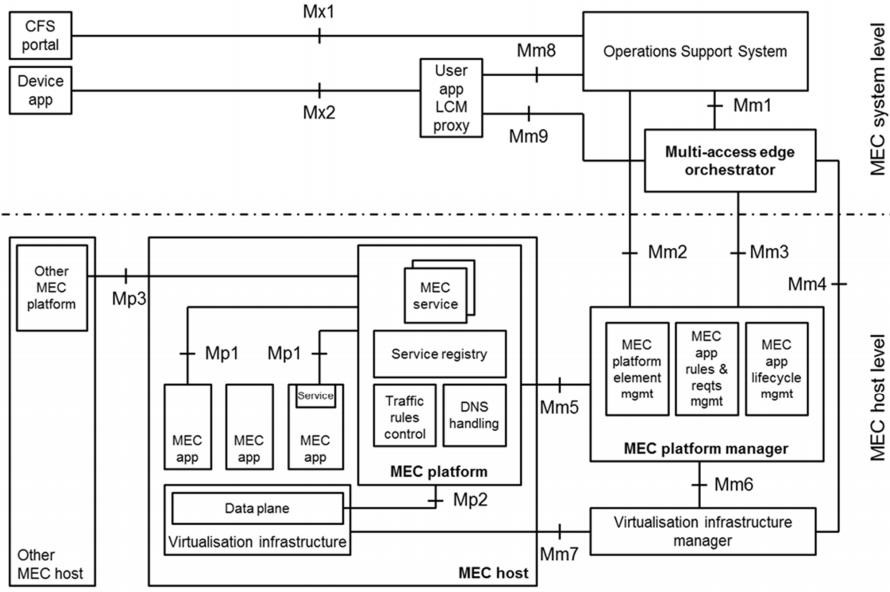5G MEC规范中的术语
Posted 边缘计算社区
tags:
篇首语:本文由小常识网(cha138.com)小编为大家整理,主要介绍了5G MEC规范中的术语相关的知识,希望对你有一定的参考价值。
1 前言
本打算跳过这篇,不过在整理文章时,发现如果略过这篇,一些看上去文字相似的词,例如:MEC管理、MEC平台、MEC系统,容易造成臆想导致的混淆;而一些平时常见的词,例如“用户应用程序”,在MEC规范中又有特殊含义,如果不做提前说明,可能也会造成误解。所以,还是按照协议顺序,补上术语汇总。毕竟,如果打算入行,免不了要使用“一致的术语”。
因为历史原因,原文中也定义了Mobile Edge Computing的相关术语,但这部分已经被Multi-access Edge Computing的对应术语取代了,所以只摘取了稍后会用到的部分术语进行汇总。
如何使用:
初看很干,能有个大概就行。更多的作用是在稍后读协议或文章时,当上下文出现了这些术语,而自己又不确认到底在说什么时,可以随时到此做个参考确认。为了保持参考价值,保留了术语原文。
作者是在看过更多协议之后的回顾整理,所以会把部分后续内容提前,以便更好的对照解释术语。
首先,把MEC的参考架构图前置到此,以便大家可以对照看看这些术语在大致说什么。
然后,会把部分容易混淆的术语,通过备注的形式,在本文中做对比分析。

图1-1:MEC参考架构图;来源:ETSI
2 术语
在MEC规范中,使用了以下术语:
汇聚点(aggregation point):在物理网络部署中,位于核心网和若干同构或异构网络终结点(例如基站,电缆调制解调器,WLAN接入点等)之间的,可以部署MEC主机的中间位置。
aggregation point: location in a physical network deployment intermediate between the core network and a number of homogeneous or heterogeneous network termination points (base station, cable modems, WLAN access points, etc.) which can act as a location for a MEC host.

图2-1:汇聚点是个相对位置(移动网络中的不同汇聚点示意)应用程序上下文(application context):有关应用程序实例的一组参考数据,可用于:标识应用程序实例、支撑生命周期管理操作、将其关联到设备应用程序(client application)。
application context: set of reference data about an application instance that is used to identify it, enable lifecycle management operations and associate it with its device application.
应用程序规则和需求(application rules and requirements):与MEC应用程序相关的规则和需求,例如:所需的资源,最大延迟,所需的或有助的服务,流量规则,DNS规则,移动性支持等。
application rules and requirements: rules and requirements associated to MEC applications, such as required resources, maximum latency, required or useful services, traffic rules, DNS rules, mobility support, etc.
客户端应用程序(client application):为了使用一个或多个特定MEC应用程序提供的功能,而需要在设备(例如UE,具有互联网连接功能的便携式计算机)上运行的应用程序程序。
client application: application software running on a device (e.g. UE, laptop with internet connectivity) in order to utilize functionality provided by one or more specific MEC application(s).
设备应用程序(device application):在设备中运行的,可以通过用户应用程序生命周期管理代理(user application lifecycle management proxy)与MEC系统(MEC system)进行交互的应用程序。
device application: application running in the device that has the capability to interact with the MEC system via the user application lifecycle management proxy.
牧之注:客户端应用程序 和 设备应用程序 有什么区别和联系吗?两者都可以运行在设备上,并且可能会有概念重叠。客户端应用程序 更多是站在用户的使用视角,即侧重于说明用户通过什么方式来使用 MEC应用程序;设备应用程序 更多是站在供应商的运维视角,即侧重于说明供应商可以通过什么方式来管理 MEC应用程序,它更多是在 用户应用程序生命周期管理代理 这个上下文中说的,在这个上下文中,MEC应用程序 就被叫做 用户应用程序。用户应用程序生命周期管理代理 可以帮助用户去代理操作 MEC应用程序 的上架、实例化和终止等操作,但它并不是一个必需组件。
合法监听(lawful interception):由网络运营商/服务供应商/接入供应商执行的,用于提供某些信息并将该信息提供给执法监控机构的,基于法律的行动。
lawful interception: action (based on the law), performed by a network operator/service provider/access provider, of making available certain information and providing that information to a law enforcement monitoring facility.
生命周期管理(lifecycle management):管理MEC应用程序实例的实例化,维护和终止所需的功能集。
lifecycle management: set of functions required to manage the instantiation, maintenance and termination of a MEC application instance.
MEC应用程序(MEC application):可以在MEC系统内的MEC主机(MEC host)上实例化并且可以潜在地提供或使用MEC服务(MEC service)的应用程序。
MEC application: application that can be instantiated on a MEC host within the MEC system and can potentially provide or consume MEC services.
MEC主机(MEC host):包含了MEC平台(MEC platform)和虚拟化基础设施的实体,后者可以为MEC应用程序(MEC application)提供计算,存储和网络资源。
MEC host: entity that contains a MEC platform and a virtualisation infrastructure which provides compute, storage and network resources to MEC applications.
MEC主机级别管理(MEC host level management):用于管理特定的MEC平台(MEC platform),MEC主机(MEC host),以及其上运行的MEC应用程序(MEC application)的MEC特定功能的管理组件。
MEC host level management: components which handle the management of the MEC specific functionality of a particular MEC platform, MEC host and the MEC applications running on it.
MEC管理(MEC management):MEC系统级别管理(MEC system level management)和MEC主机级别管理(MEC host level management)。
MEC management: MEC system level management and MEC host level management.
MEC平台(MEC platform):在特定的MEC主机虚拟化基础设施上运行MEC应用程序(MEC application)并使它们能够提供和使用MEC服务(MEC service)所需的功能集,并且其自身也可以提供若干MEC服务。
MEC platform: collection of functionality that is required to run MEC applications on a specific MEC host virtualisation infrastructure and to enable them to provide and consume MEC services, and that can provide itself a number of MEC services.
MEC服务(MEC service):由MEC平台本身或MEC应用程序通过MEC平台提供的服务。
MEC service: service provided via the MEC platform either by the MEC platform itself or by a MEC application.
MEC系统(MEC system):运行MEC应用程序所需的MEC主机(MEC host)和MEC管理(MEC management)的集合。
MEC system: collection of MEC hosts and MEC management necessary to run MEC applications.
MEC系统级别管理(MEC system level management):掌握完整MEC系统概况的管理组件。
MEC system level management: management components which have the overview of the complete MEC system.
多接入边缘计算(Multi-access Edge Computing):在包含一种或多种接入技术的接入网络边缘的,紧邻用户NFV的,提供IT服务环境和云计算能力的系统。NFV,网络功能虚拟化,是在ETSI GS NFV 003 [i.1]中定义的一套原则:通过使用虚拟硬件抽象,将网络功能从运行它们的硬件中分离。
Multi-access Edge Computing: system which provides an IT service environment and cloud-computing capabilities at the edge of an access network which contains one or more type of access technology, and in close proximity to its users Network Functions Virtualisation (NFV): principle of separating network functions from the hardware they run on by using virtual hardware abstraction, as defined in ETSI GS NFV 003 [i.1].
保留数据(retained data):与特定服务事务(transaction)相关的特定订户/用户的数据元素集。
retained data: set of data elements for a specific subscriber/user related to a specific service transaction.
用户应用程序(user application):用于响应用户通过设备应用程序(device application)发起请求的,在MEC系统(MEC system)中实例化的MEC应用程序(MEC application)。
user application: MEC application that is instantiated in the MEC system in response to a request from a user via a device application.
用户上下文(user context):与应用程序用户相关联的,由MEC应用程序(MEC application)维护的,应用程序特定的运行时数据。
user context: application-specific runtime data maintained by the MEC application, which is associated with a user of that application.
用户设备(User Equipment, UE):接入运营商移动网络的,并支持应用程序通过移动网络传输其IP数据包的移动设备。注意:用户设备最初是在 ETSI TS 123 002 [i.2] 中定义的。本规范中使用上述定义代替。
User Equipment (UE): mobile equipment used to access the operator's mobile network and supporting applications that transmit IP packets over the mobile network.
NOTE: User Equipment is originally defined in ETSI TS 123 002 [i.2]. For the purpose of the present document, the definition above is used instead.
虚拟资源(virtualised resource):由虚拟化基础设施提供给MEC应用程序的计算,存储或网络资源。
virtualised resource: compute, storage or network resource provided by the virtualisation infrastructure to a mobile edge application.
3 参考
ETSI GS MEC 001 V2.1.1 (2019-01)
以上是关于5G MEC规范中的术语的主要内容,如果未能解决你的问题,请参考以下文章